Abstract
Phosphorus (P) is vital for the growth of crops, and its absorption efficiency is closely linked to the traits of the plants. Further research is needed to understand how vegetable crops adjust to changes in P availability and how their root morphology and physiology are affected by high P levels in the shoots. In this study, eight Chinese cabbage (Brassica rapa pekinensis) genotypes were grown in a culture room under 0, 25, 50, 100, 150, 300, 600, 900, and 1200 mg kg−1 concentrations of P to evaluate root responses in order to define various adaptive strategies in relation to P acquisition. We selected high-PE and low-PE Chinese cabbage in order to identify how different P efficiency groups responded to P supply and shoot P concentration. P supply level and shoot P concentration significantly affected growth. With the increase in the P supply level, the growth variable characteristics of Chinese cabbage first increased and then decreased or increased first and then stabilized. But it was found that P300 was the most suitable level for Chinese cabbage growth. At the same P supply level, high-PE cabbages had higher shoot dry weight and P absorption capacity, stronger root traits, and higher plasticity as compared to low-PE cabbages. The optimal shoot P concentration is 2.1 mg g−1 and 1.7 mg g−1 for low- and high-PE cabbages, respectively. The root morphological traits performed greatly when the shoot P concentration was at the optimal concentration. The low-PE cabbages had greater shoot growth traits, and high-PE cabbages had higher root dry weight and P absorption. This study offers valuable insights to improve P management by analyzing the relationships between soil P dynamics and root processes in the cultivation of Chinese cabbage.
1. Introduction
Phosphorus (P) availability is a key constraint for crop production under multiple environmental conditions [1]. The P availability in soil is typically low, but it has the ability to adsorb and fix 92.46% to 99.15% of phosphorus. Approximately 58% to 89% of the P fertilizer added is absorbed by the soil [2,3]. Plants alter root morphological traits with an adaptation ability to low P stress, such as by increasing root length, specific root length, and root diameter to expand nutrient absorption area [4,5,6]. Moreover, plants also alter physiological traits that enhance the ability of roots to secrete protons, organic anions, and phosphatases [7,8].
Roots are a key organ for nutrient acquisition and transportation, and the response of root architecture to P deficiency is important for plant growth and development [9]. The capacity of P acquisition is closely linked to changes in root morphological and physiological traits [10]. The adaptability of root morphology traits in reaction to internal P stress determines the evolution of root characteristics over time [11]. Chickpea (Cicer arietinum) genotypes showed large plasticity in root biomass allocation, rhizosheath pH, and carboxylate amount, root traits which ultimately enhance the P acquisition of plants under specific soil P conditions [12]. The seminal root length and the root hair density of rice (Oryza sativa L.) increased, whereas lateral root density decreased under low P conditions to maintain plant growth [9]. Cotton (Gossypium hirsutum L.) seedlings reduced the average diameter of roots, promoted root extension, expanded the root coverage area to enhance the range of P acquisition, and improved the adaptability to low P [6]. Some species prefer to regulate root secretions to activate the fixed P in the surrounding soil, instead of enhancing root traits [13]. In wheat (Triticum aestivum L.), the expression levels of genes related to the amino acid metabolism pathways were significantly upregulated in leaves and roots in response to low P stress [14]. Phosphorus stress induced the activation of acid phosphatase and catalase/peroxidase activities in both stems and roots of P-tolerant genotypes of maize (Zea mays L.) earlier than in the P-sensitive genotypes [15]. The results of these studies suggest that the P uptake by crops of different genotypes can be regulated by altering rhizosphere secretions.
Due to commercial breeding and artificial domestication, crop genotypes have lost their capacity to adapt to nutritional stress. Currently, “excessive fertilization” is a major issue with agricultural production in the majority of areas. It is necessary to explore the appropriate nutrient supply level to meet the optimal growth state of crops. A method involving soil P absorption and transportation to enhance crop yield has been widely utilized to optimize P utilization. Teng et al. [16] indicated the critical P supply for wheat plants to absorb sufficient P under experimental conditions. Lowering the P fertilizer inputs required for optimal growth of plants would improve the P-use efficiency of these agricultural systems [17]. Different plant species have developed different strategies to regulate root morphological and physiological responses to variable P supply. Six cultivars of Trifolium subterraneum L. responded relatively similarly to P supply in terms of shoot and root dry mass [18]. Average root diameter, specific root length, and the amount of rhizosphere carboxylates varied among the genotypes. Therefore, it is important to further explore the responses of different species or varieties of the same crop to varying levels of P supply. Previous research has indicated that root traits in white lupin (Lupinus albus L.) were influenced by the shoot P concentration, with this process also being significantly impacted by the localized external P supply [19]. An increase in shoot P concentration in maize resulted in a reduction in root morphological responses and an increase in root exudation. Maize roots were found to respond to P deficiency based more on their morphological rather than physiological traits [20].
The majority of research studies have traditionally centered on major food crops like wheat and maize, with limited attention given to understanding how shoot and root traits of vegetable crops respond to varying P levels. Chinese cabbage (Brassica rapa pekinensis) is a globally important vegetable crop with unique characteristics. Previous research has demonstrated significant variations in Chinese cabbage traits in response to different levels of P supply [21]. Soybean (Glycine max L.) genotypes that are efficient in P utilization were found to stimulate sugar metabolism in roots and release H+ ions into the root hair zone, leading to acidification of the rhizosphere as a strategy to counteract P deficiency. These P-efficient genotypes exhibited enhanced mechanisms and stronger defense mechanisms against P deficiency compared to P-inefficient genotypes [8]. The impact of P supply levels on the growth of Chinese cabbage and the relationship between P absorption efficiency (PE) and the traits of Chinese cabbage remain unclear. It is important to investigate how varying P levels influence the growth of Chinese cabbage and whether there is a correlation between P absorption efficiency and the traits of Chinese cabbage. Further research is needed to explore these relationships and enhance our understanding of P uptake and utilization in Chinese cabbage plants. To address these questions, we hypothesized that the P absorption efficiency of Chinese cabbages, whether high or low, is correlated with their responses to varying levels of P supply. The objectives of this study encompassed: (1) investigating the changes in root traits in Chinese cabbage plants with high- and low-PE, grown in soil with nine different levels of P supply; (2) characterizing the interaction between root morphological and physiological responses and shoot P concentration, spanning from deficient to optimal levels, and even to excess P. By conducting these analyses, we aimed to shed light on how root traits and responses are linked to shoot P concentrations, and how they relate to the absorption efficiency of Chinese cabbage plants.
2. Materials and Methods
2.1. Experimental Material and Sowing Plan
The study was conducted following a randomized complete block design, involving two factors: P efficiency (PE) of Chinese cabbage (high-PE and low-PE) and 9 P supply levels (0, 25, 50, 100, 150, 300, 600, 900, and 1200 P mg kg−1 soil, phosphorus was supplied as KH2PO4). The experiment was conducted with four replicates, and pots within each block were re-randomized on a weekly basis to minimize the effects of plant location within blocks.
The low-P soil (the plot has been idle for two years) was collected from Dagudian (114°30′ E, 39°05′ N), Baoding, China. Soil properties were as follows: pH 8.08 (1:5, soil: water ratio), organic matter 14.9 g kg−1, total N 0.74 g kg−1, Olsen-P 10.4 mg kg−1 and available K 113.9 mg kg−1. The soil was sieved (2 mm) and mixed thoroughly to grow plants in plastic pots of 12 cm in height and 9 cm in diameter (0.5 kg dry soil per pot).
2.2. Soil Collection and Chinese Cabbage Seed
Four hybrids were used, which were commercially available in the market, and four inbred lines were obtained from the College of Horticulture, Hebei Agricultural University (115°26′31″ E, 38°49′23″ N), Baoding, China. All the nutrients before the seeds were planted. The nutrient solutions were added to the soil as basal fertilizers at the following rates (mg kg−1): Ca (NO3)2·4H2O (1687), K2SO4 (335), CaCl2 (126), MgSO4·7H2O (43), EDTA-FeNa (5.8), MnSO4·4H2O (6.7), ZnSO4·7H2O (10), CuSO4·5H2O (2.0), and H3BO3 (0.68). The soil K content was standardized by administering the appropriate quantity of K2SO4 to establish uniform soil K conditions across all nine P treatments. The Chinese cabbage seeds were surface sterilized by being soaked in a 10% v/v H2O2 solution for 30 min, rinsed, and then germinated on wet filter paper at 25 °C for 24 h in the dark. Three uniformly germinated seeds were transferred into each pot. After one week of germination, the seedlings were thinned, leaving one plant per pot. Throughout the entire experimental period, the soil moisture levels were maintained at 70% of the water-holding capacity. This was determined gravimetrically by weighing the pots every three days and adding de-ionized water as needed to keep the soil moisture at the desired level. In a controlled culture room, the temperatures ranged from 20 °C at night to 25 °C during the day. LED lights were applied for 14 h, from 06:00 h to 20:00 h, providing a light intensity of 9000 LUS (Lumens per square meter). The potted experiment was carried out between 20 May 2023 and 20 June 2023 at the western campus of Hebei Agricultural University, located at coordinates 115°26′31″ E, 38°49′3″ N in Baoding, China.
2.3. Harvest and Measurements
Plant height was measured by using a ruler and vernier caliper before harvest. Leaf chlorophyll content (SPAD) was measured by using chlorophyll METER SPAD-502 plus (Konica Minolta). Plants were harvested and shoots and roots were cut separately. Shoots were oven-dried at 75 °C for 48 h, weighed, and then ground to fine powder. Shoot P concentration was determined via the standard Molybdenum-antimony-scandium colorimetry after digestion in a H2SO4-H2O2 mixture at 360 °C for 3 h. P content consists of shoot P concentration × shoot dry weight, and root P concentration × root dry weight [22].
The roots were gently shaken to remove bulk soil, with soil adhered, and the rhizosphere soil was collected by brushing it off. The rhizosphere soil was stored at −20 °C for a subsequent measurement of rhizosphere soil pH and acid phosphatase activity. The acid phosphatase activity of the rhizosphere soil was determined using the acid phosphatase kit of Beijing Solaibao Technology Co., Ltd., Beijing, China. Root samples were cleaned using de-ionized water. The roots were dispersed in water in a transparent tray (30 × 20 × 3 cm) and scanned by a scanner (Epson Expression 1600 pro, Nagano, Japan. 400 dpi resolution). The root images obtained via scanning were analyzed using Win-Rhizo software 2024a (Regent Instruments Inc., Quebec, QC, Canada) to calculate root length, root surface, fine root length, and root tissue density. Once the root samples were scanned, they were oven-dried at 75 °C for 48 h and weighed to determine the root dry weight. Subsequently, the root/shoot ratio was calculated.
2.4. Calculation and Data Analyses
Factor analysis of growth traits, as well as comprehensive scores, were carried out. The factor analysis of growth traits was conducted to identify the underlying dimensions influencing these traits. Comprehensive scores were calculated based on the extracted factors to evaluate the overall performance or contribution of each growth trait. The result showed that the highest score was under P600 (Table 1). Phosphorus efficiency was determined by calculating the shoot dry weight at the 0 mg kg−1 P level divided by the shoot dry weight at 600 mg kg−1 P for each of the eight Chinese cabbage genotypes, based on their respective mean values. The four higher genotypes were considered as high-PE cabbages, and the four lower ones were considered as low-PE cabbages (Table 2).

Table 1.
Optimal phosphorus supply level suitable for Chinese cabbage growth and determined by factor analysis.

Table 2.
Calculation and classification of P efficiency of Chinese cabbage. Calculated as the value of “shoot dry weight at P0/shoot dry weight at P600”. The values are arranged from large to small and are divided into four high-PE and four low-PE genotypes according to their respective P efficiency values.
To assess the response of high- and low-PE Chinese cabbage to varying P supply levels, we conducted a two-way ANOVA with a randomized block design to analyze the impact of P supply, the two PE groups, and their interaction. All statistical analyses were performed by using the SPSS 20.0 statistical software (IBM Corp., Armonk, NY, USA). Differences at the 0.05 significance level were compared using the Fisher LSD significant difference test and constructed in Origin 2020b (OriginLab, Northampton, MA, USA). Amos Graphics was used for path analysis. To investigate the correlation between traits of Chinese cabbage and shoot P concentration, we analyzed the relationship between these traits and shoot P concentration using the polynomial fitting method.
3. Results
3.1. Phosphorus Supply and Efficiency Impact on Chinese Cabbage Traits
A two-factor variance analysis was conducted on Chinese cabbage traits to investigate the impact of varying P efficiency types and P supply levels. The results indicate significant effects on 16 traits by P supply levels (p < 0.01, Table 3) and 13 traits by P efficiency types (p < 0.05, Table 3), with only 6 traits showing significant interactions (p < 0.01, Table 3). Additionally, it was observed that rhizosphere soil pH was not significantly affected by the factors considered in this analysis.

Table 3.
Two-way analysis of variance (ANOVA) for the Chinese cabbage traits between P efficiency (PE) of Chinese cabbage and P supply (p < 0.05).
3.2. Shoot/Root Dry Weight, P Concentration and P Content
Shoot/root dry weight, P concentration and P content were significantly influenced by P supply (p < 0.001, Table 3). Shoot P concentration, root dry weight, and root P content were significantly influenced by P efficiency and P supply (p < 0.01, Table 3). Increasing P supply from 0 (P0) to 1200 (P1200) mg P kg−1 resulted in significant increases in shoot and root dry weight of both high- and low-PE cabbages. Specifically, the shoot dry weight of high-PE cabbages increased by 196.25% and root dry weight by 214.29%, while low-PE cabbages showed increases of 211.90% in shoot dry weight and 315.67% in root dry weight (Figure 1a,b). Initially, both shoot and root dry weight increased with rising P supply, with high-PE cabbages reaching peak shoot dry weight at P150 and peak root dry weight at P300, whereas low-PE cabbages achieved the highest root dry weight at P600. Moreover, the shoot dry weight of low-PE cabbages exceeded that of high-PE cabbages above P150 (Figure 1a). Interestingly, beyond P600, shoot and root P concentrations remained constant despite increasing P supply, leading to a decrease in P content in both shoot and root tissues (Figure 1c–f).
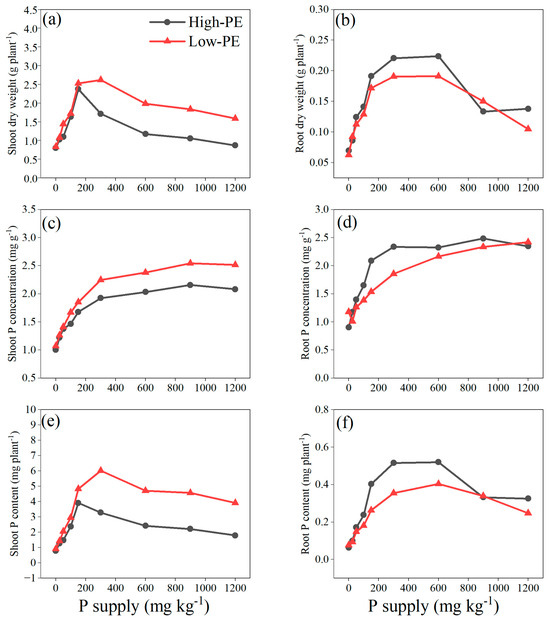
Figure 1.
The effect of P supply on shoot dry weight (a), root dry weight (b), shoot P concentration (c), root P concentration (d), shoot P content (e) and root P content (f).
The regression analysis demonstrated that the relationship between shoot and root dry weight and shoot P concentration followed a polynomial model, as illustrated in Figure 2 and Figure S1. The peak shoot dry weight for high-PE cabbages occurred at a shoot P concentration of approximately 1.70 mg g−1 near P200, whereas low-PE cabbages reached a maximal shoot dry weight at a shoot P concentration of roughly 2.11 mg g−1 near P900 (Figure 2). Similarly, the peak root dry weight for high-PE cabbages was observed at a shoot P concentration of around 2.61 mg g−1 near P900, while low-PE cabbages achieved maximum root dry weight at a shoot P concentration of approximately 2.12 mg g−1 near P300 (Figure 2). Comparing the maximum shoot dry weight, it was found that low-PE cabbages exhibited a 55.89% higher value than high-PE cabbages, while the maximum root dry weight of high-PE cabbages was 8.90% higher than that of low-PE cabbages (Figure 2a,b).
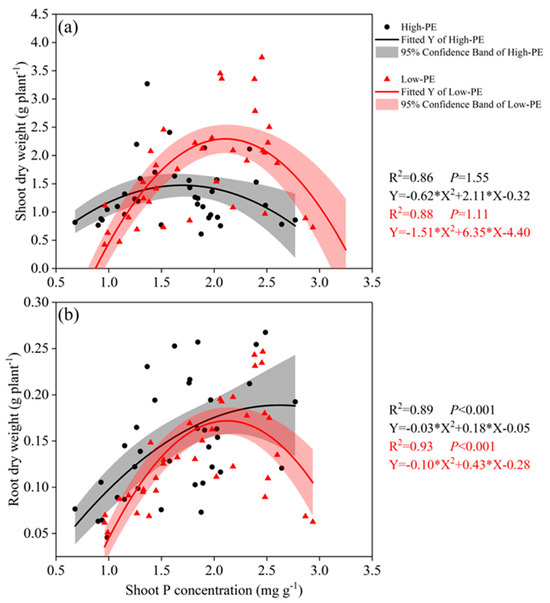
Figure 2.
The effect of shoot P concentration on shoot dry weight (a) and root dry weight (b).
3.3. Plant Height and SPAD
Initially, both plant height and leaf chlorophyll content (SPAD) values increased with the rise in P supply, eventually leveling off once the P supply exceeded P600 (Figure 3). However, despite the variations in P supply levels, the differences among the nine levels were not deemed significant (p < 0.05, Figure S2). Both high-PE and low-PE cabbages exhibited an increase in plant height in conjunction with shoot P concentration initially, reaching their peaks at approximately 1.91 mg g−1 (near P300) and 2.52 mg g−1 (near P900), respectively (Figure 4a). Notably, beyond a shoot P concentration of about 1.80 mg g−1, the plant height of low-PE cabbages surpassed that of high-PE cabbages significantly (Figure 4a). In the shoot P concentration range of 0.96 to 2.77 mg g−1, the SPAD values of high-PE cabbages were notably higher than those of low-PE cabbages (Figure 4b). The results suggest that optimal shoot P concentrations play a critical role in achieving maximum plant growth and chlorophyll content.
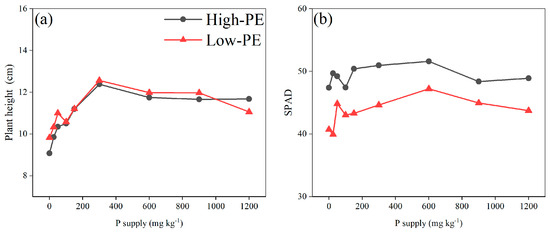
Figure 3.
The effect of P supply on plant height (a) and SPAD (b).
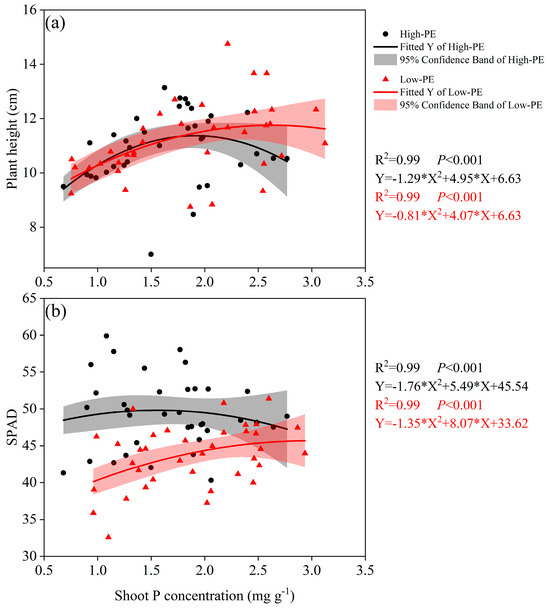
Figure 4.
The effect of shoot P concentration on plant height (a) and SPAD (b).
3.4. Root Traits
Significantly influenced by P supply (p < 0.001, Table 3), root traits (excluding rhizosphere soil pH) demonstrated a noteworthy relationship with soil P levels (p < 0.05, Figure S3). Initially, root length, surface area, volume, and diameter all increased in conjunction with soil P supply. Root length and volume peaked at P300, while root surface area and diameter reached their highest levels at P600 (Figure 5a–d). Specific root length exhibited a decrease with increasing P supply until P200, followed by a gradual increase to a plateau with further P increments. Interestingly, the root traits of low-PE cabbages surpassed those of high-PE cabbages, showing higher values for root length, surface area, diameter, and specific root length (Figure 5). Furthermore, above P150, the root/shoot ratio of high-PE cabbages significantly exceeded that of low-PE cabbages, with both reaching their maximum at P600 (Figure 5e). The rhizosphere soil pH maintained relative stability (Figure 5h), while root tissue density and acid phosphatase activity initially rose with soil P supply before declining after reaching a plateau (Figure 5g,i).
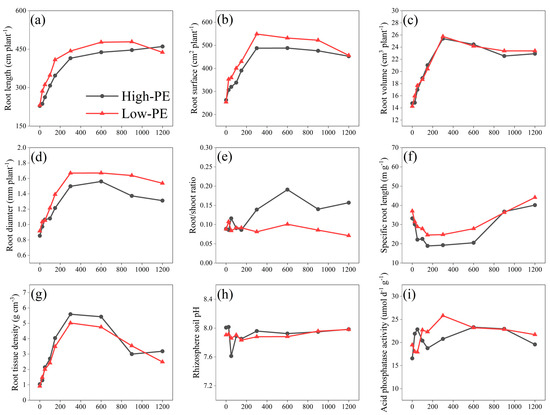
Figure 5.
The effect of P supply on root length (a), root surface (b), root volume (c), root diameter (d), root/shoot ratio (e), specific root length (f), roo tissue density (g), rhizosphere soil pH (h) and acid phosphatase activity (i).
Initially, root length, volume, and diameter showed a positive correlation with increasing shoot P concentration, with low-PE cabbages displaying higher values compared to high-PE counterparts as shoot P concentration rose (Figure 6a,c,d). Notably, at shoot P concentrations ranging from about 1.29 (near P50) to 2.45 mg g−1 (near P600), the root surface of low-PE cabbages surpassed that of high-PE cabbages (Figure 6b). Specific root length exhibited a decrease followed by an increase as shoot P concentration rose, with the lowest value observed at approximately 1.75 mg g−1; furthermore, the specific root length of low-PE cabbages exceeded that of high-PE cabbages (Figure 6f). Initially increasing in response to the rising shoot P concentration, root tissue density was higher in high-PE cabbages compared to low-PE cabbages (Figure 6g). Moreover, acid phosphatase activity increased in low-PE cabbages but decreased in high-PE cabbages with increasing shoot P concentration, with the former showing higher activity levels when shoot P concentrations ranged from approximately 1.25 to 2.40 mg g−1 (Figure 6i). The intricate interplay between shoot P concentration and root traits, as well as root tissue density and acid phosphatase activity, sheds light on the contrasting responses of low- and high-PE cabbages to varying levels of P availability.
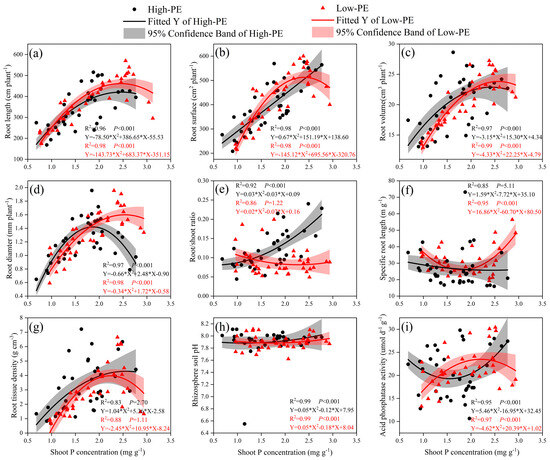
Figure 6.
The effect of shoot P concentration on root length (a), root surface (b), root volume (c), root diameter (d), root/shoot ratio (e), specific root length (f), roo tissue density (g), rhizosphere soil pH (h) and acid phosphatase activity (i).
3.5. Path Analysis of Root Traits on Shoot and Root Dry Weight
Phosphorus supply level had a positive effect on root length and root diameter for the high-PE and low-PE cabbages (p < 0.05, Figure 7). In high-PE cabbages, the level of P supply positively influenced root diameter and indirectly increased root dry weight. Acid phosphatase activity facilitated the development of root surface area but did not enhance shoot P absorption. Root length had a significantly positive impact on both root surface area and root volume. Additionally, root surface area directly and indirectly contributed to shoot P absorption and shoot dry weight (p < 0.05, Figure 7a). In low-PE cabbages, the P supply level indirectly facilitated shoot P absorption through root P absorption. Phosphorus supply level had positive impacts on root length and diameter, with these traits in turn leading to increases in root surface area and root volume. Additionally, root length significantly contributed to the accumulation of both shoot and root dry weight (p < 0.05, Figure 7b). These results emphasize the intricate relationships between P supply, root traits, and physiological processes in low-PE and high-PE cabbages, highlighting the need for tailored nutrient management approaches to optimize cabbage growth and productivity.
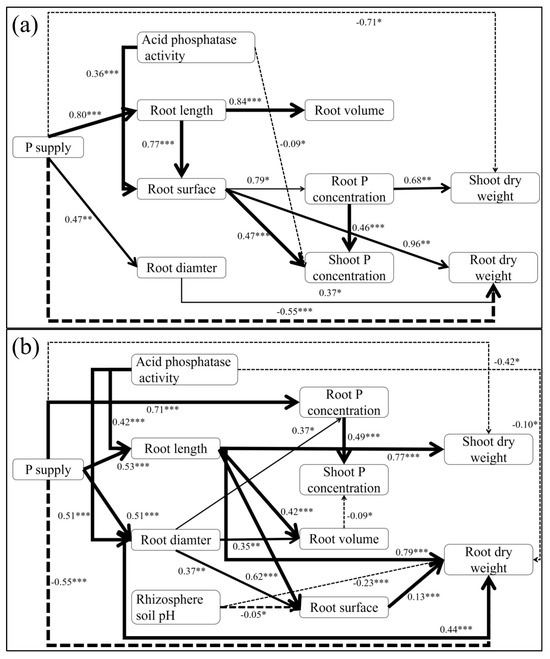
Figure 7.
Path analysis of root traits on shoot and root dry weight of high-PE (a) and low-PE (b) Chinese cabbages. *—p < 0.05, **—p < 0.01, ***—p < 0.001. The dashed line represents a significance value greater than 0.05, while the solid line represents a significance value less than 0.05. The line thickness, from thick to thin, corresponds to significance values <0.05, <0.01, <0.001, respectively.
4. Discussion
4.1. The Relationship Between Chinese Cabbage Traits and P Supply Levels
The shoot dry weight and P concentration exhibited a pattern of initially increasing and then decreasing with higher levels of P supply. Notably, low-PE cabbages displayed significantly higher shoot dry weight and P concentration compared to high-PE cabbages. However, within the P200–P800 range, the root dry weight and P concentration of high-PE cabbages surpassed those of low-PE cabbages. This discrepancy may be attributed to the inhibitory effects of low P stress on the synthesis of key enzymes involved in P transport, including fructose, mannose, and invertase [23]. The level of P supply had a significant impact on promoting root growth. Specifically, in low-PE cabbages, the root length directly influenced the shoot dry weight in a positive manner with a high level of statistical significance (p < 0.001, Figure 7). On the other hand, in high-PE cabbages, root length indirectly facilitated the accumulation of shoot dry weight through its influence on root P concentration, albeit with a slightly lower level of statistical significance (p < 0.05, Figure 7). This demonstrates the intricate relationship between root development, nutrient uptake, and shoot growth in response to varying levels of P availability in cabbages with different P efficiency. In the study by Wang et al. [24], it was highlighted that a greater root length was advantageous for P acquisition in wheat genotypes. In the case of high-PE cabbages, the absorption of P by the roots and the accumulation of root dry weight acted as mediators for P uptake in the shoots and the subsequent growth of the shoots. As a result, it can be inferred that low-PE cabbages may be more favorable for a conservation breeding strategy, particularly when considering the same level of P supply.
In our research, we observed that specific root traits displayed greater levels of plasticity when subjected to P stress, with root length, specific root length, root surface area, and root diameter being the most prominent traits affected. This enhanced plasticity in root traits is often linked to improved strategies for resource acquisition (Figure 5). Interestingly, we found that low-PE cabbages exhibited higher values for root length, specific root length, root surface area, and root diameter compared to high-PE cabbages (Figure 5). This suggests that low-PE cabbages may possess a more flexible and robust root system that is better equipped to adapt and thrive under P stress conditions, enabling more efficient acquisitions of vital resources for growth and development. To ensure nutrient supply, plants increased the exploration range for P in soil by increasing root length, root surface area, and root diameter under low P stress [5,6]. Plants demonstrate resource acquisition strategies by developing specific traits such as longer root length and specific root length. These traits play a crucial role in enabling plants to effectively explore a larger soil volume in search of essential nutrients and water [12,25]. In addition to root length and specific root length, root diameter is a critical trait that significantly contributes to expanding the soil exploration range for P, particularly in low-PE cabbage plants. Root diameter plays an essential role in penetrating compacted soils, with larger diameter roots offering an advantage in effectively navigating through challenging soil conditions [26,27]. Conversely, while the growth of larger diameter roots is advantageous for soil exploration, it also helps to decrease the metabolic costs associated with building and maintaining the root system [28]. Our research findings align with the concept that P supply levels contribute to the development of root diameter. Additionally, the root surface area showed a positive correlation with root diameter, which was particularly noticeable in low-PE cabbage plants (p < 0.01, Figure 7). In low P soil conditions, low-PE cabbage genotypes tend to allocate a greater amount of metabolic energy toward constructing their root systems to better access P resources across a broader soil area. Conversely, high-PE cabbages demonstrate a contrasting trend (Figure 5). It is widely observed that plants respond to low P stress by increasing their root/shoot ratio and specific root length [29,30]. This phenomenon indicates that plants under P stress allocate a larger portion of carbon resources toward new root growth, enhancing their capability to explore and extract P from the soil [31]. Our findings indicate that within a range from sufficient to excess P supply, root traits remained relatively stable (Figure 5). This stability suggests that at high P supply levels, soil P availability is no longer a limiting factor for plant growth, leading to consistent root traits across different P supply levels.
In sum, the corresponding differences between high-PE and low-PE cabbages in soil P levels were mainly attributed to the contribution of roots, and the plasticity of roots determined their P uptake strategies (resource-acquiring or resource-conservative). The more plastic root traits of Chinese cabbage are more conducive to maintaining better phenotypic characteristics in phosphorus deficiency environments. In the research of Chinese cabbage breeding, the relationship between root traits and phenotypic characteristics should be considered in order to better support agricultural sustainable development.
4.2. The Relationship Between Chinese Cabbage Traits and Shoot P Concentration
Shoot P concentration can serve as an effective indicator of P limitation in plants and is also utilized as a reliable tool for diagnosing yield depressions in plants. By analyzing shoot P concentration, researchers and farmers can assess the nutrient status of plants and identify potential limitations that may be impacting plant growth and yield [32,33]. According to our results, shoot P concentration showed an increase with higher P supply levels (Figure 1). Additionally, shoot dry weight initially increased and then decreased with increasing P supply levels (Figure 2). Specifically, for high-PE and low-PE cabbages, the critical shoot P concentration levels for achieving optimal shoot dry weight were determined to be 1.70 mg g−1 (near P200) and 2.11 mg g−1 (near P900), respectively. These findings highlight the importance of maintaining appropriate shoot P concentrations to optimize plant growth and yield in cabbages. The experiment conducted was effective in assessing the root morphological and physiological responses to shoot P concentration across different levels, including deficiency, optimum, and excess. Furthermore, the results also revealed that the root dry weight of high-PE cabbages consistently exceeded that of low-PE cabbages across the entire range of shoot P concentrations (as shown in Figure 2). This suggests a strong correlation between root dry weight and shoot P concentration, indicating that root development and growth are influenced by the P availability in the shoot. This information can be valuable for understanding the complex relationships between shoot and root growth in response to varying nutrient levels, and for optimizing P management strategies in cabbage cultivation. Root traits are known to play a crucial role in P uptake in plants. In our study, a wide range of root traits were observed to vary with increasing shoot P concentration, spanning from severe P deficiency to excess P levels (as shown in Figure 6). These root traits exhibited diverse responses, with notable differences observed between high-PE and low-PE cabbages (Figure 6). Of particular interest was the positive relationship observed between root lengths and specific root lengths of low-PE cabbages with increasing shoot P concentration, consistently higher than that of high-PE cabbages. This finding led us to speculate that root lengths and specific root lengths of low-PE cabbages may be crucial factors in the acquisition of P resources in Chinese cabbage (Figure 6a,f).
The analysis of root traits revealed that both root volume and root diameter exhibited similar trends, with low-PE cabbages surpassing high-PE cabbages around a shoot P concentration of approximately 1.9 mg g−1, as depicted in Figure 6c,d. This observation suggests that low-PE cabbages may possess a greater capacity for root volume and diameter plasticity under conditions of sufficient P. Interestingly, the root surface area and acid phosphatase activity of high-PE cabbages were found to be higher than those of low-PE cabbages when experiencing P deficiency or excess, with the trend reversing when P levels were abundant (as shown in Figure 6b,i). This indicates that high-PE cabbages may exhibit enhanced root surface area and acid phosphatase activity in response to P stress conditions, while low-PE cabbages may have a more robust response under optimal P conditions. Overall, these findings suggest that the plasticity potential of root volume and diameter in low-PE cabbages, as well as the differential responses in root surface area and acid phosphatase activity between high-PE and low-PE cabbages, play key roles in P uptake and utilization strategies in Chinese cabbage plants. Understanding these variations in root traits can provide valuable insights for enhancing P uptake efficiency and nutrient management in agricultural systems. This could be due to the contribution of acid phosphatase activity, and the increase in acid phosphatase directly promotes the increase in root surface for the high-PE cabbage (Figure 7). Under low P conditions, plants often respond by increasing the activity of enzymes such as acid phosphatase [34].
5. Conclusions
The findings of this study indicate that Chinese cabbage varieties with different P efficiencies respond significantly differently to varying levels of soil P supply. Under conditions of P deficiency, sufficiency, and excess, the low-PE cabbages exhibited higher root lengths and specific root lengths compared to the high-PE cabbages. This trend likely contributed to enhanced shoot P absorption and increased shoot dry weight in low-PE cabbages. On the other hand, the root system of high-PE cabbages played a critical role in facilitating shoot P absorption. Overall, the results suggest that low-PE cabbages may be more suitable for intensive agricultural practices due to their superior performance in terms of root traits and shoot P absorption.
Notably, under similar P supply levels (exceeding 150 mg kg−1), low-PE cabbages demonstrated higher shoot dry weight and P concentration compared to high-PE cabbages. These findings underscore the importance of optimizing P supply for maximizing crop yield and highlight the relevance of developing tailored P management strategies based on soil conditions and rhizosphere interactions. However, we only studied the seedling stage of Chinese cabbage, and there are still limitations: while early crop nutrient uptake and nutrition are critical, early physiological responses do not necessarily translate to similar responses at later growth stages.
Supplementary Materials
The following supporting information can be downloaded at: https://www.mdpi.com/article/10.3390/agronomy15010130/s1, Figure S1: Effect of P supply on shoot, root dry weight, P concentration and content of Chinese cabbage with high-PE or low-PE, Figure S2: Effect of P supply on plant height and SPAD of Chinese cabbage with high-PE or low-PE, Figure S3: Effect of P supply on root traits of Chinese cabbage with high-PE or low-PE. Different lower-case letters denotes significant differences due to the different P source treatment (p < 0.05).
Author Contributions
Conceptualization, R.Z. and S.H.; formal analysis, R.Z. and S.H.; writing—original draft preparation, R.Z. and S.H.; writing—review and editing, R.Z., S.H., C.Z., H.W. and X.W.; visualization, R.Z. and S.H.; supervision, R.Z. and X.W.; project administration, R.Z. and X.W.; funding acquisition, R.Z. and X.W. All authors have read and agreed to the published version of the manuscript.
Funding
This study was financially supported by Natural Science Basic Research Program of Shaanxi Province (2021JLM-25), Hebei Agriculture Research System (HBCT2023100208), the State Key Laboratory of North China Crop Improvement and Regulation (NCCIR2021ZZ-18) and the Earmarked Fund for CARS (CARS-23).
Data Availability Statement
The data presented in this study are available on request from the corresponding author.
Conflicts of Interest
The authors declare no conflicts of interest.
References
- Chen, Y.L.; Rengel, Z.; Palta, J.; Siddique, K.H.M. Efficient root systems for enhancing tolerance of crops to water and phosphorus limitation. Indian Soc. Plant Physiol. 2018, 23, 689–696. [Google Scholar] [CrossRef]
- Riskin, S.H.; Porder, S.; NeillC Figueira, A.M.E.S.; Tubbesing, C.; Mahowald, N. The fate of phosphorus fertilizer in Amazon soya bean fields. Philosophical transactions of the Royal Society of London. Ser. B Biol. Sci. 2013, 368, 20120154. [Google Scholar]
- Nierves Mary, C.P.; Salas Felix, M. Assessment of soil phosphorus and phosphorus fixing capacity of three vegetable farms at cabintan, Ormoc City, Leyte. World J. Agric. Res. 2015, 3, 70–73. [Google Scholar]
- Reddy, V.R.P.; Aski, M.S.; Mishra, G.P.; Dikshit, H.K.; Singh, A.; Pandey, R.; Singh, M.P.; Gayacharan, R.V.; Priti, R.N.; Nair, R.M. Genetic variation for root architectural traits in response to phosphorus deficiency in mungbean at the seedling stage. PLoS ONE 2020, 15, 0221008. [Google Scholar] [CrossRef] [PubMed]
- Soumya, P.R.; Sharma, S.; Meena, M.K.; Pandey, R. Response of diverse bread wheat genotypes in terms of root architectural traits at seedling stage in response to low phosphorus stress. Plant Physiol. Rep. 2020, 26, 152–161. [Google Scholar] [CrossRef]
- Zhang, Z.C.; Zhu, L.X.; Li, D.X.; Wang, N.; Sun, H.C.; Zhang, Y.J.; Zhang, K.; Li, A.C.; Bai, Z.Y.; Li, C.D.; et al. In situ root phenotypes of cotton seedlings under phosphorus stress revealed through rhizopot. Front. Plant Sci. 2021, 12, 716691. [Google Scholar] [CrossRef] [PubMed]
- Gerke, J. The acquisition of phosphate by higher plants: Effect of carboxylate release by the roots. A critical review. J. Plant Nutr. Soil Sci. 2015, 178, 351–364. [Google Scholar] [CrossRef]
- Zhu, Q.; Wang, H.; Shan, Y.Z.; Ma, H.Y.; Wang, H.Y.; Xie, F.T.; Ao, X. Physiological response of phosphorus-efficient and inefficient soybean genotypes under phosphorus-deficiency. Russ. J. Plant Physiol. 2020, 67, 175–184. [Google Scholar] [CrossRef]
- Sun, H.W.; Guo, X.L.; Xu, F.G.; Wu, D.X.; Zhang, X.H.; Lou, M.M.; Luo, F.F.; Xu, G.H.; Zhang, Y.L. Overexpression of OsPIN2 regulates root growth and formation in response to phosphate deficiency in rice. Int. J. Mol. Sci. 2019, 20, 5144. [Google Scholar] [CrossRef] [PubMed]
- Tang, H.L.; Chen, X.Y.; Gao, Y.J.; Hong, L.J.; Chen, Y.L. Alteration in root morphological and physiological traits of two maize cultivars in response to phosphorus deficiency. Rhizosphere 2020, 14, 100201. [Google Scholar] [CrossRef]
- Becquer, A.; Haling, R.E.; Warren, A.; Hull, R.A.; Stefanski, A.; Richardson, A.E.; Ryan, M.H.; Kidd, D.R.; Lambers, H.; Sandral, G.A.; et al. Critical phosphorus requirements of Trifolium species: The importance of root morphology and root acclimation in response to phosphorus stress. Physiol. Plant. 2021, 173, 1030–1047. [Google Scholar] [CrossRef]
- Wen, Z.H.; Pang, J.Y.; Tueux, G.; Liu, Y.F.; Shen, J.B.; Ryan, M.H.; Lambers, H.; Siddique, K.H.M. Contrasting patterns in biomass allocation, root morphology and mycorrhizal symbiosis for phosphorus acquisition among 20 chickpea genotypes with different amounts of rhizosheath carboxylates. Funct. Ecol. 2020, 34, 1365–2435. [Google Scholar] [CrossRef]
- Gu, J.C.; Yu, S.Q.; Sun, Y.; Wang, Z.Q.; Guo, D.L. Influence of root structure on root survivorship: An analysis of 18 tree species using a minirhizotron method. Ecol. Res. 2011, 26, 755–762. [Google Scholar] [CrossRef]
- Wang, J.; Qin, Q.; Pan, J.J.; Sun, L.J.; Sun, Y.F.; Xue, Y.; Song, K. Transcriptome analysis in roots and leaves of wheat seedlings in response to low-phosphorus stress. Sci. Rep. 2019, 9, 19802. [Google Scholar] [CrossRef]
- Du, Q.G.; Wang, K.; Xu, C.; Zou, C.; Xie, C.X.; Xu, Y.B.; Li, W.X. Strand-specific RNA-Seq transcriptome analysis of genotypes with and without low-phosphorus tolerance provides novel insights into phosphorus-use efficiency in maize. BMC Plant Biol. 2016, 16, 222. [Google Scholar] [CrossRef] [PubMed]
- Teng, W.; Deng, Y.; Chen, X.P.; Xu, X.F.; Chen, R.Y.; Lv, Y.; Zhao, Y.Y.; Zhao, X.Q.; He, X.; Li, B.; et al. Characterization of root response to phosphorus supply from morphology to gene analysis in field-grown wheat. J. Exp. Bot. 2013, 64, 1403–1411. [Google Scholar] [CrossRef] [PubMed]
- Simpson, R.J.; Richardson, A.E.; Nichols, S.N.; Crush, J.R. Pasture plants and soil fertility management to improve the efficiency of phosphorus fertiliser use in temperate grassland systems. Crop Pasture Sci. 2014, 65, 556–575. [Google Scholar] [CrossRef]
- Jeffery, R.P.; Simpson, R.J.; Lambers, H.; Kidd, D.R.; Ryan, M.H. Root morphology acclimation to phosphorus supply by six cultivars of Trifolium subterraneum L. Plant Soil 2017, 412, 21–34. [Google Scholar] [CrossRef]
- Shen, J.; Li, H.; Neumann, G.; Zhang, F. Nutrient uptake, cluster root formation and exudation of protons and citrate in Lupinus albus as affected by localized supply of phosphorus in a split-root system. Plant Sci. 2005, 168, 837–845. [Google Scholar] [CrossRef]
- Wen, Z.H.; Li, H.G.; Shen, J.B.; Rengel, Z. Maize responds to low shoot P concentration by altering root morphology rather than increasing root exudation. Plant Soil 2017, 416, 377–389. [Google Scholar] [CrossRef]
- Hou, S.S.; Pu, Z.T.; Zhang, R.F.; Zhang, C.; Wang, H.; Wang, X.X.; Zhao, J.J. Shoot and root traits are associated with varying soil phosphorus supply in Chinese cabbage. J. Soil Sci. Plant Nutr. 2024, 24, 4280–4293. [Google Scholar]
- Bao, S.D. Soil and Agricultural Chemistry Analysis, 3rd ed.; China Agriculture Press: Beijing, China, 2020. [Google Scholar]
- Li, H.Y.; Xu, L.T.; Li, J.X.; Lyu, X.C.; Li, S.; Wang, C.; Wang, X.L.; Ma, C.M.; Yan, C. Multi-omics analysis of the regulatory effects of low-phosphorus stress on phosphorus transport in soybean roots. Front. Plant Sci. 2022, 13, 992036. [Google Scholar] [CrossRef] [PubMed]
- Wang, X.X.; Zhang, J.Q.; Wang, H.; Rengel, Z.; Li, H.B. Plasticity and co-variation of root traits govern differential phosphorus acquisition among 20 wheat genotypes. Oikos 2023, 2023, 08606. [Google Scholar] [CrossRef]
- Luo, B.W.; Ma, P.; Nie, Z.; Zhang, X.; He, X.; Ding, X.; Feng, X.; Lu, Q.X.; Ren, Z.Y.; Lin, H.J.; et al. Metabolite profiling and genome-wide association studies reveal response mechanisms of phosphorus deficiency in maize seedling. Plant J. 2019, 97, 947–969. [Google Scholar] [CrossRef] [PubMed]
- Bengough, A.G.; McKenzie, B.M.; Hallett, P.D.; Valentine, T.A. Root elongation, water stress, and mechanical impedance: A review of limiting stresses and beneficial root tip traits. J. Exp. Bot. 2011, 62, 59–68. [Google Scholar] [CrossRef] [PubMed]
- Clark, L.J.; Price, A.; Steele, K.A. Evidence from nearisogenic lines that root penetration increases with root diameter and bending stiffness in rice. Funct. Plant Biol. 2008, 35, 1163–1171. [Google Scholar] [CrossRef] [PubMed]
- Eissenstat, D.M. Costs and benefits of constructing roots of small diameter. J. Plant Nutr. 1992, 15, 763–782. [Google Scholar] [CrossRef]
- Zhang, Y.; Yu, P.; Peng, Y.F.; Li, X.X.; Chen, F.J.; Li, C.J. Fine root patterning and balanced inorganic phosphorus distribution in the soil indicate distinctive adaptation of maize plants to phosphorus deficiency. Pedosphere 2012, 22, 870–877. [Google Scholar] [CrossRef]
- Deng, Y.; Chen, K.R.; Teng, W.; Zhan, A.; Tong, Y.P.; Feng, G.; Cui, Z.P.; Zhang, F.S.; Chen, X.P. Is the inherent potential of maize roots efficient for soil phosphorus acquisition? PLoS ONE 2014, 9, 90287. [Google Scholar] [CrossRef] [PubMed]
- Fernandez, M.C.; Rubio, G. Root morphological traits related to phosphorus-uptake efficiency of soybean, sunflower, and maize. J. Plant Nutr. Soil Sci. 2015, 178, 807–815. [Google Scholar] [CrossRef]
- Barry, D.; Miller, M. Phosphorus nutritional requirement of maize seedlings for maximum yield. Agron. J. 1989, 81, 95–99. [Google Scholar] [CrossRef]
- Bollons, H.M.; Barraclough, P.B. Assessing the phosphorus status of winter wheat crops: Inorganic orthophosphate in whole shoots. J. Agric. Sci. 1999, 133, 285–295. [Google Scholar] [CrossRef]
- Ciereszko, I.; Szczygla, A.; Zebrowska, E. Phosphate deficiency affects acid phosphatase activity and growth of two wheat varieties. J. Plant Nutr. 2011, 34, 815–829. [Google Scholar] [CrossRef]
Disclaimer/Publisher’s Note: The statements, opinions and data contained in all publications are solely those of the individual author(s) and contributor(s) and not of MDPI and/or the editor(s). MDPI and/or the editor(s) disclaim responsibility for any injury to people or property resulting from any ideas, methods, instructions or products referred to in the content. |
© 2025 by the authors. Licensee MDPI, Basel, Switzerland. This article is an open access article distributed under the terms and conditions of the Creative Commons Attribution (CC BY) license (https://creativecommons.org/licenses/by/4.0/).